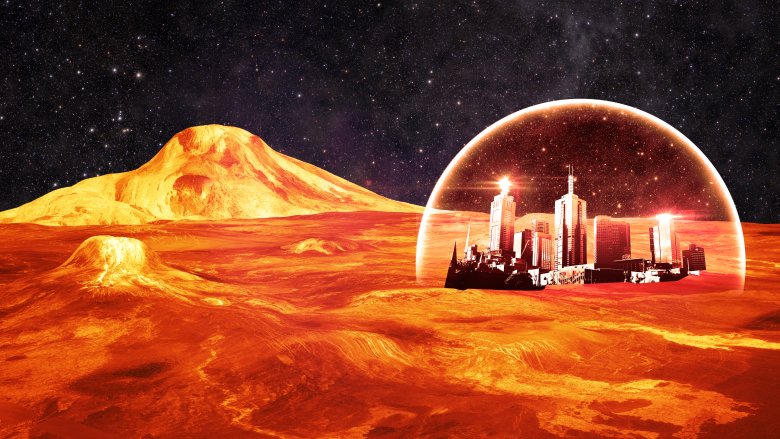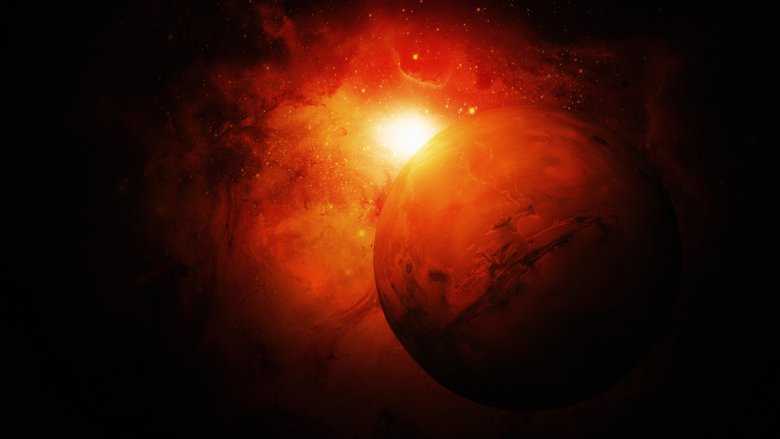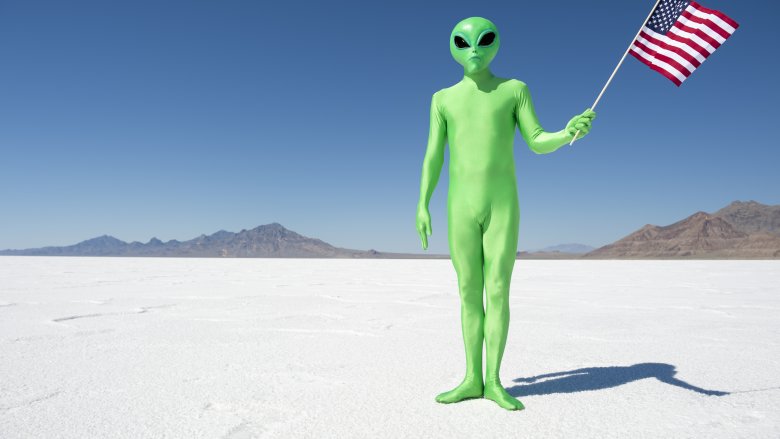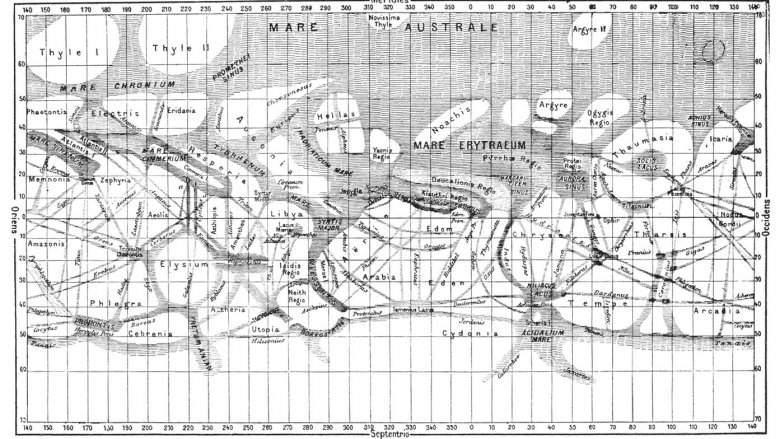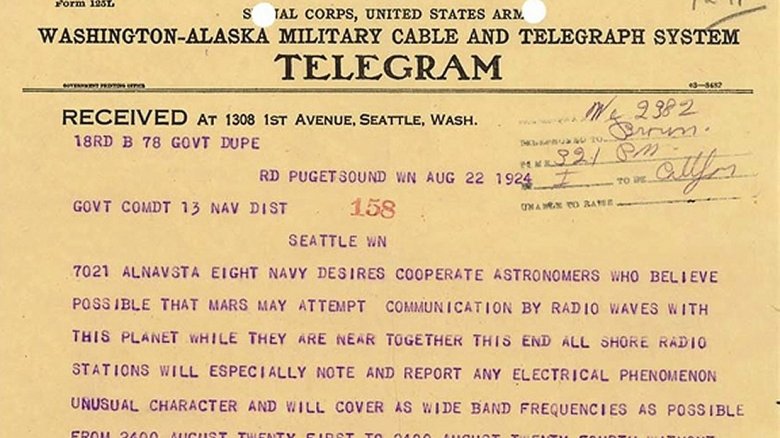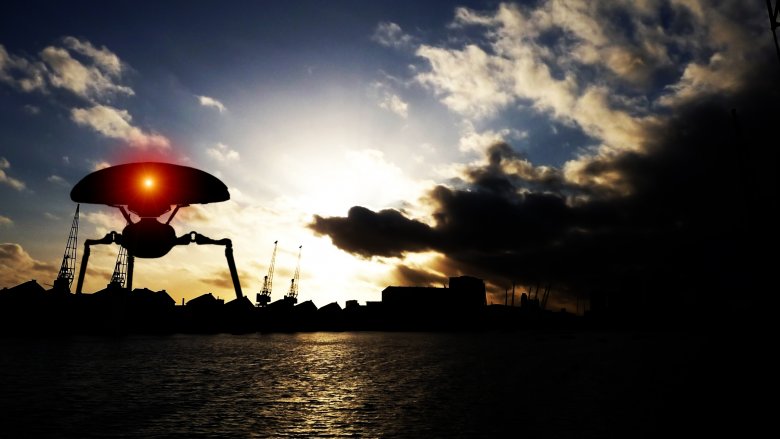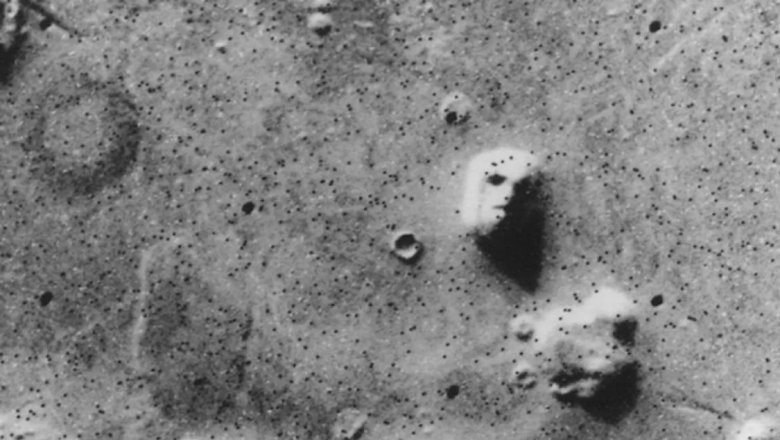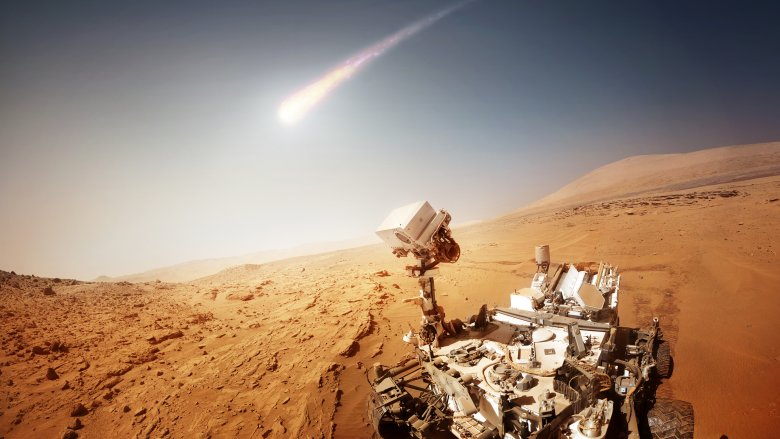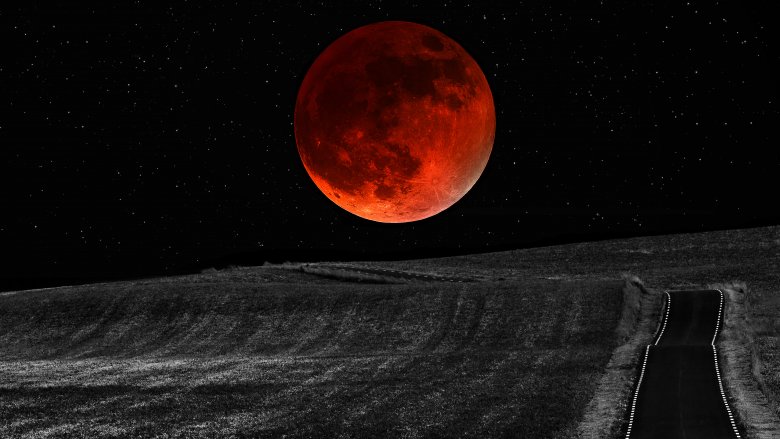Weirdest Things People Ever Believed About Mars
Ever since humankind has gazed out upon the vastness of space, a weird little red planet has looked back at us. Sure, Saturn has those cool rings, and that neglected "dwarf planet" Pluto is the Milky Way's underdog, but let's face it, Mars is everyone's favorite alien world. Maybe that's why Earthlings have spent centuries pondering what sort of life might exist on that big, ruddy orb, whether it's microbes or a giant rocky face.
That Mars was a god
In all fairness, imagine yourself back in 3000 B.C.E. — back in the stark days when computers were still a handful of millennia away from being created — and imagine that after watching the night sky for a couple months, you notice this weird red speck doing a loop through the stars. What would you think? Back then, the closest equivalent to Wikipedia was the village elder, and if you asked him, he'd tell you that the red light was Nergal, the god of war. Makes sense, right?
According to Professor Eric S. Rabkin's Mars: A Tour of the Human Imagination, the Mesopotamians didn't prioritize Nergal that much, compared to other gods because the whole "war" concept wasn't a big hullabaloo for them. Sorry, red guy. However, the centuries passed by, Nergal earned a couple of new names, and he gained increasing importance, according to NASA. First, the Egyptians called him Mars Har Decher — "the Red One" — and later, the Greeks referred to him as Ares, a character who now spends his time fighting Wonder Woman. It was the Roman Empire who finally christened the red guy with the name "Mars," and as we know from history, those Roman conquerors took the whole idea of "war" a lot more seriously than the Mesopotamians.
That Martian lives are just like ours
Everyone eventually figured out that Mars was just a rock in space, not a conscious deity. However, since our blue rock is populated by people, it took us Earthlings a long time to shake the notion that the red rock was probably populated by people, as well.
Naturally, humans wanted to see what those weird Martian folks looked like. So in the late 1700s, British astronomer Sir William Herschel built some telescopes, pointed them at the sky, and looked at Mars. As pointed out by NASA, Herschel correctly noted that Mars had polar caps, as well as a tenuous atmosphere. According to the BBC, he also made the accurate deduction that Mars had seasons, just like Earth does. However, his biggest calculation was way off: Noticing that Mars had both dark areas and light ones, he decided the dark spots were obviously vast oceans. Oops.
Based on the environmental conditions Herschel observed, he comfortably determined that the Martians "probably enjoy a situation similar to our own." Great news, right? Anyway, Herschel's writings made the thought of Earthling/Martian conversations seem a lot more realistic. In the next century, Mars fever took off in a big way.
That Mars was covered with artificial canals
OK, here's where the Martian craze really ignited. According to NASA, the 19th century saw the growth of bigger and better telescopes, one of which was wielded in 1877 by the Italian astronomer Giovanni Virginio Schiaparelli, who directed the Brera Observatory in Milan. One day, Schiaparelli decided to give himself the awesome job of drawing the first map of Mars, giving memorable names to a bunch of "oceans" and "continents" which, sadly, didn't actually exist. Amid these imaginary landmasses, he also noticed what appeared to be natural water channels, which he called canali.
This is where things got skewed. When Schiaparelli's work was translated, the Italian "canali" sounded a lot like the English word "canal." As in, you know, artificial, man-made waterways. Picture yourself living in the late 1800s. You see a big news story about how "canals" have been mapped out on Mars, so what would you think? Yep, that's right: intelligent life. Everyone got hyped up about these artificial Martian canals, and before Schiaparelli could say, "Hey, wait, I meant channels," word of Martian life was buzzing through the air like cicadas.
That Mars was the home to an advanced ancient civilization
Lots of people were excited about those crazy cool Martian canals, but no one as much as American astronomer Percival Lowell, according to Popular Mechanics. Lowell was loaded with cash, so he set up shop in Flagstaff, Arizona, looked up at the red planet, and started making his own observations about the Martian canals. Lowell passionately believed in life on Mars, and according to Space, he even argued that Mars had once been covered with beautiful plant life, before the land had dried up like a raisin. Thus, Lowell concluded that the canals had been built as a way to transport water to the many red, hot, dry deserts across the Martian landscape, in what amounted to a high-tech "save the world" effort by the Martians. Because of these great Martian efforts, Lowell concluded that they were way more intelligent than Earthlings.
Meanwhile, over in Italy, Schiaparelli was understandably annoyed about Lowell's obsession, which by this point had totally overshadowed Shiaparelli's actual work. But let's face it, natural channels are a lot less fun than an advanced civilization trying to save their world, so it was Lowell's writings that caught fire with the public. As Slate reported, Lowell's Mars sketches were even adapted into a handcrafted wooden globe by Emmy Brun, which must be an amazing collector's item.
That Nikola Tesla talked to Martians
Yeah, that's right. The same Nikola Tesla who revolutionized electricity, designed remote-controlled boats, and said he'd invented an "earthquake machine" had one more incredible achievement up his sleeve: He claimed to have made contact with Martians. And honestly, if there was any person in history whom we'd believe had legitimately contacted aliens, it would be an otherworldly genius like Tesla.
As written in The Electrical Age, Vol. 30, it was all the way back in 1901 when Tesla announced to the newspapers that he had communicated via radio with the people of Mars. Now, keep in mind, while such a claim would sound outlandish today, it seemed credible at the time. Thanks to people like Percival Lowell, the general public had every reason to think that there was life on Mars, and Tesla was known for his incredible discoveries. However, looking at it today ... well, Tesla didn't quite manage the feat he thought he did. No, he wasn't lying, but his assumptions were a little off. According to History, it turned out the signals Tesla picked up on were actually emitted by cosmic gas clouds, not aliens. Still, we've gotta give Tesla credit for trying.
That Martians would say hello to the U.S. military in 1924
As far as we know, Martians don't exist. Nonetheless, these fictional alien beings have seriously impacted popular culture, history, and even military strategies, the latter of which occurred in August of 1924, according to io9, when astronomers announced that our little blue planet was about to see its closest opposition to Mars in over a century. Basically, this meant Mars and Earth were like two roommates trying out a "friends with benefits" situation and pushing their beds in the Milky Way a little closer together ... but only for a few days, before going back to normal.
Figuring that a closer proximity to Mars meant a higher likelihood of radio contact with our Martian neighbors, Professor David Todd of Amherst College corralled the U.S. Navy and Army into going quiet for three days and listening intently for Martian communications. His argument was that if we were ever going to "hear" the Martians, this was the time. The military shrugged, figured "why not?" and for three days, held a glass to the wall interplanetary wall, waiting for Mars to say howdy. Unfortunately, those antisocial Martians ghosted us once again, evidently preferring the imaginary company of Nikola Tesla.
That 'War of the Worlds' set off a mass hysteria
Well, no, it didn't. This legend falls into the weird category of "misconception about a misconception." Sure, Orson Welles' War of the Worlds radio drama — which depicted a hostile Martian invasion of Earth, based on the H.G. Wells novel — was the height of entertainment back in 1938. However, that whole story you've been told about the U.S. population going bonkers because they thought it was a real news report? Nah, it didn't happen.
As Slate describes, the vast majority of the population wasn't even listening to War of the Worlds when it first aired, and those who did listen were fully aware it was a drama, not a real-life report. The "hysteria" controversy was something drummed up by the newspapers, which were trying to make the radio stations (which might threaten the paper-pushing business) look bad, and by now, this fictional hysteria story has been repeated so often that it's become a part of everyone's collective memory. To be fair, some people got scared. At least one listener sued CBS, the broadcaster, for $50,000, though her claim was dismissed. Otherwise? No panic in the streets, no mass suicides, none of that. So yeah, when it comes to outlandish beliefs that people have had about Martians, you can file this myth as something weird that people believe today, not back then.
That there was a 'face' on Mars
Belief in life on Mars cooled off considerably over the course of the 20th century, probably because once Earthling spacecraft actually landed on that rocky red surface, it became pretty obvious nobody was living there. Yeah, it was a letdown, but you can't always get what you want. Then in 1976, according to NASA, the Viking 1 spacecraft went circling around the Martian globe, snapping photos. One of these pictures showed a rock formation (above) that appeared eerily similar to a human face.
The scientists figured "ah, no biggie," and released the photo to the public, figuring people would think it was cool. Instead, everyone went absolutely nuts over the so-called "Face on Mars," trying to understand what had caused it. Was it a giant alien monument? Fossil evidence of the giant humanoids who had once populated the red planet? The face of God? Without realizing it, NASA had opened a huge can of worms, and when they argued that it was just a pile of rocks, people accused them of conspiracy.
Well, unfortunately for believers of the Face on Mars — and just as unfortunately for NASA itself, which would certainly get a lot more funding if they did find aliens — new photos of the "face" were taken in 1998, which proved that it was, indeed, just a pile of rocks.
That Martian bacteria had been found on a meteorite
These days, hunting for life on Mars has become a lot more boring. Instead of hunting down giant crabs, green humanoids, or the cacodemons from Doom, we're now just looking for evidence that life may have had the conditions to exist at one point, maybe. A big maybe. If Mars did ever have life, it most likely was microscopic, single-celled, and didn't have sharp teeth.
In 1996, according to the Smithsonian, a brief but wonderful hubbub occurred when a 4.5 billion-year-old meteorite was found in Antarctica, formed from Martian rocks. After studying it, scientists announced that the rocks contained microscopic evidence of the same compounds that are created by Earth's microbes, as well as chains resembling the ones formed by Earth bacteria. That's right, alien bacteria fossils! Proof!
Not quite. Since that big day in 1996, countless scientists have researched the patterns in the rock and come to the conclusion that it doesn't prove much of anything. The most damning evidence of all came from environmental microbiologist Andrew Steele, who concluded that the Martian meteorite was contaminated by bacteria from Earth. But hey, maybe it's better if we don't all get infected with Martian germs.
That Mars will be as big as the Moon in the sky
Every August, an urban legend about Mars appearing in our sky flies across the internet, filling the inboxes, news feeds, and streams of the world. Basically, the story goes that on a certain date in August — for example, August 27 — Mars will pass so close to the Earth that if you look up into the night sky, it will appear just as large as the Moon. Awesome!
Unfortunately, nah, it ain't gonna happen. Not last August, not this August, and not in any August to come. According to Slate, this online meme has been circulating since the MySpace days of 2003, probably based on an understandable misconception of a confusing reality. In reality, that year, if you had looked through a telescope with a magnified image of 75x, Mars would look about the same size (in the telescope) as a non-magnified Moon looks in the regular ol' Earth sky (with no telescope). See, that's cool, but not so cinematic. Most likely, the now-infamous chain message started because someone glanced at an article, skimmed the details, and got so excited about seeing a giant red Mars in the sky that they pinged all their friends. Needless to say, they probably had a really disappointing night.
As for why the story somehow resurfaces every August, well, we can only blame pranksters. In real life, our sky will never be so lucky, but hey, maybe it'll happen in a Black Mirror episode someday.
That Martian society was wiped out by a nuclear explosion
You might think the big thought experiments regarding ancient Martian civilizations went the way of the dodo after Percival Lowell's maps were proven false, but if so, you'd be wrong. These days, the mascot of Mars is a distinguished UC Davis plasma physicist named Dr. John Brandenburg, who has a rather bizarre fixation on extinct Martian societies, according to Vice. Brandenburg believes that Mars once possessed two big cities, Utopia and Cydonia, both of which had technology comparable to ancient Egypt. Tragically, these twin societies were wiped off the map by nuclear explosions, many centuries ago. Bye-bye, Martian life. Hello, blighted red landscape. As evidence, Brandenburg and fellow believers point to the "remains" of Martian structures seen in NASA photos.
The obvious dilemma with this theory, on a story level, is that while ancient Egyptians made some incredible pyramids, they certainly didn't have nukes. Back in 2011, Brandenburg answered this criticism by stating that the nuclear explosions were "natural," having been set off by a cosmic accident. Since then, his story has taken a darker turn, and he now argues that Martian civilization got nuked to oblivion by some sort of alien enemy from another world.
Needless to say, most scientists aren't too worried. But if some alien despot does someday come along and threaten to nuke Earth — "Just like I did on Mars!" — then hey, at least we were warned.
